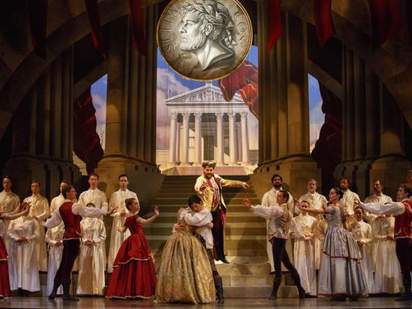 A scene from Opera Atelier's Lucio Silla.
A scene from Opera Atelier's Lucio Silla. Silla is an “opera seria” – and as stage director Marshall Pynkoski suggested in his remarks before the curtain, the opera comes with certain built-in challenges. The piece lacks the spontaneity of later Mozart operas, and is based on rigid musical formulas: da capo arias, interspersed with swathes of recitative. Apparently, some people find opera seria boring – and Pynkoski was almost apologetic on this point.
As well, it helped that Opera Atelier relied mostly on a cast of regulars – experienced singing actors who are simpatico with the company’s style of delivery and movement. (After three decades of period opera production, OA has built up a useful stable of such performers.)
Cast in the title role is Krešimir Špicer. There’s a dramatic edge to his sturdy tenor voice, and a solidity to his stage-presence that makes him well suited to the role of a Roman general. Špicer was clearly in his element as a Snidley Whiplash-style villain – but he also handled Silla’s transformation into a benevolent ruler at the opera’s end with credible conviction.
Opposite Špicer, as the unwilling object of Silla’s desires, is soprano Meghan Lindsay as Giunia. Initially, her presence was not especially strong, either vocally or dramatically. But as the opera unfolded, she found her way into her character’s inner fortitude. She was downright fearsome, as she brandished a knife and poured hostility on Silla. (Indeed, Silla has so many enemies hating on him with murderous intent, it’s a wonder he survives to Act II.)
Because good castratos are hard to find these days, two sopranos appeared in trouser roles. Both Peggy Kriha Dye and Inga Kalna (a newcomer to the OA stage) brought a masculine swagger and a virile vocal energy to their roles – Cecilio and Cinna, respectively. Both displayed impressive control and stamina in their extended arias. And as Silla’s sister Celia, soprano Mireille Asselin was a light and pretty-sounding foil to the other women on stage.
The Opera Atelier Chorus were costumed as Roman senators, in a rare on-stage appearance. (Usually, in OA productions, they’re placed in a balcony, wearing black.) They were a welcome presence – and it would be nice to see them brought down from the balcony more often.
I’m not quite sure that OA’s Corps de Ballet, led by Jeannette Lajeunesse Zingg, is always an apt contribution to this production. At times, their poised and elegant presence seemed forced. But I was impressed by the neatly choreographed Act II sword-fight, in which Cecilio bravely confronts five of Silla’s guards.
In the pit, the Tafelmusik Orchestra sounded splendid, and music director David Fallis kept tempi brisk and forward moving.
So who says opera seria is boring? Probably not anyone who saw this OA production when it premiered at the Salzburg Festival in 2013 – or anyone who saw the revival at Milan’s La Scala last year. Now, Toronto audiences can finally see what all the fuss is about. And I don’t think anyone at the Elgin Theatre on Tuesday evening would have called Lucio Silla boring, either.
© Colin Eatock 2016
 RSS Feed
RSS Feed

